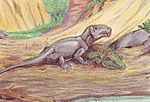1838 in paleontology
 From Wikipedia the free encyclopedia
From Wikipedia the free encyclopedia
| |||
|---|---|---|---|
| +... |
Paleontology or palaeontology is the study of prehistoric life forms on Earth through the examination of plant and animal fossils.[1] This includes the study of body fossils, tracks (ichnites), burrows, cast-off parts, fossilised feces (coprolites), palynomorphs and chemical residues. Because humans have encountered fossils for millennia, paleontology has a long history both before and after becoming formalized as a science. This article records significant discoveries and events related to paleontology that occurred or were published in the year 1838.
Plesiosaurs
[edit]New taxa
[edit]| Name | Status | Authors | Notes | |
|---|---|---|---|---|
| Valid | Meyer | |||
| Valid | von Meyer | |||
Synapsids
[edit]Non-mammalian
[edit]| Name | Status | Authors | Age | Unit | Location | Notes | Images |
|---|---|---|---|---|---|---|---|
| Kutorga | A member of Dinocephalia. |  | |||||
| Nomen dubium | Kutorga | Late Permian | A member of Dinocephalia. | ||||
| Valid | Kutorga | A member of Dinocephalia. |
References
[edit]- ^ Gini-Newman, Garfield; Graham, Elizabeth (2001). Echoes from the past: world history to the 16th century. Toronto: McGraw-Hill Ryerson Ltd. ISBN 9780070887398. OCLC 46769716.